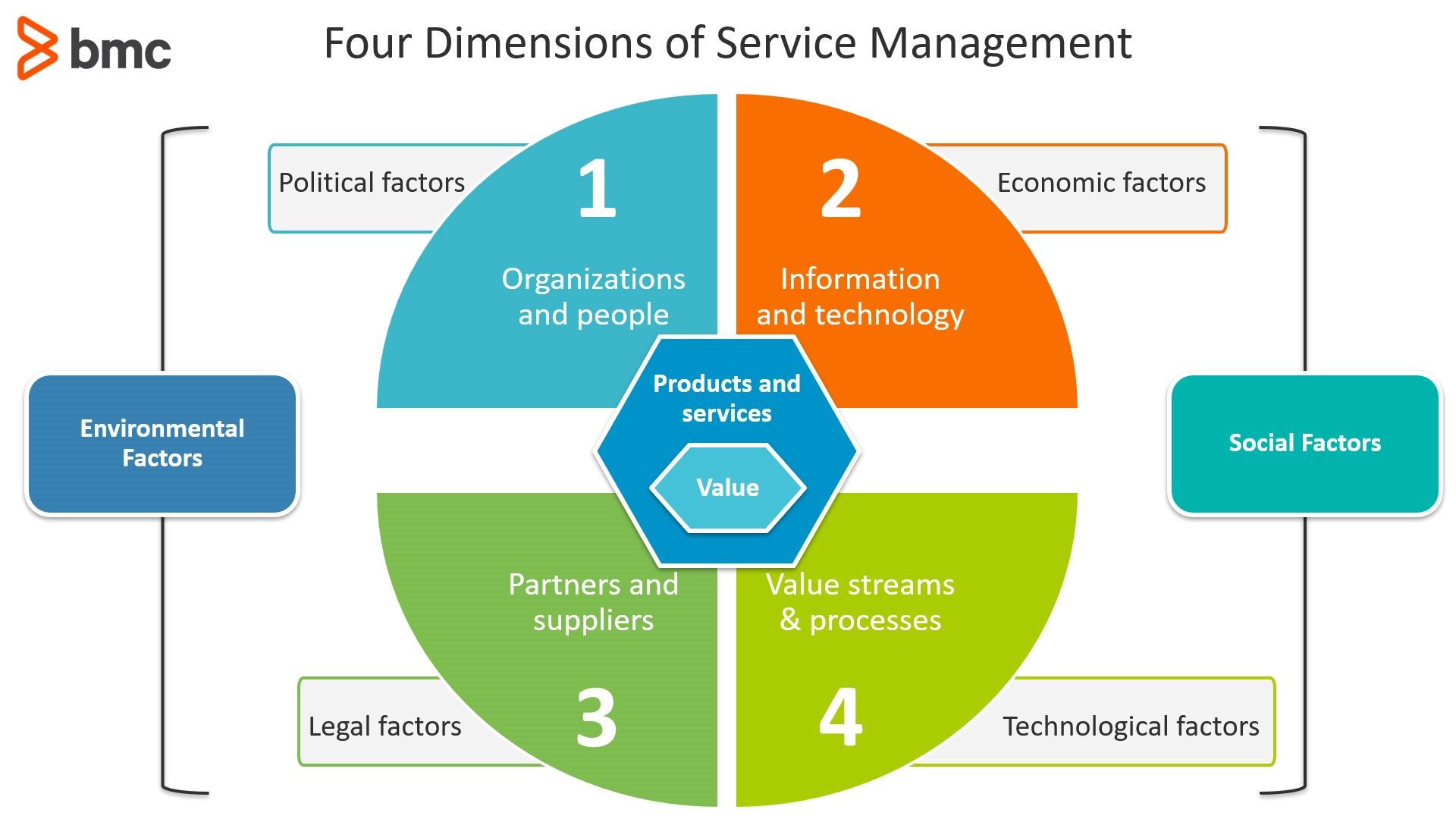When I was first introduced to the ITIL® framework at the beginning of the millennium, we were urged to consider people, process, and technology when looking at IT-enabled services. This was known as the PPT framework or the Golden Triangle.
ITIL 4 has broadened this view, adding partners to the mix. Four critical elements of IT service management now form the basis of the four dimensions of ITIL: organizations and people, value streams and processes, Information and technology, and partners and suppliers.
Whether you implement ITIL 4 wholly or use it as one tool among many to inform your IT service management strategy, you must consider all four dimensions when designing a new service or making changes to an existing one. In this article, we’ll look at:
- The original PPT framework and why it changed
- How each of the four dimensions is vital to value delivery
- Actionable best practices
The Golden Triangle no more?
Traditionally, companies approached IT service delivery in myriad ways, from ad-hoc to structured, with some efforts more successful than others. Over time, the Golden Triangle approach emerged, aimed at guiding organizations in decision making by prioritizing certain factors. Companies often recited the PPT approach:
- People first
- Processes second
- Technology third
Today, of course, we do business differently. The internet and cloud computing have revolutionized everything, including service and value delivery. Organically, a fourth dimension came to the fore: partners. Our relationships with third-party partners and suppliers have meant that more organization can deliver value without necessarily becoming a technology business.
Where some argue that the Golden Triangle is dead, it may be best to reframe our thinking of people, processes, and technology to include partners. Instead of prioritizing one dimension over the others, this new approach introduces us to thinking multi-dimensionally, considering each dimension as we design or change our services.

People
This sits at the top of the list, for good reason. In New Zealand we have a Māori saying that is relevant here:
“He aha te mea nui o te ao. He tāngata, he tāngata, he tāngata”.
This translates to “What is the most important thing in the world? It is people, it is people, it is people.” Without people and the organizations they form, you have no service.
When IT is your daily focus, it’s easy to lose sight of the real reason we do what we do. Technology exists only to provide value to the people your business serves. That’s why your people must be at the forefront of every decision you make and every service you design or change—if there is no value to your customers, why are you doing it?
Best practice: When designing a service, always think about who will use the service, including where, when, and how they’ll use it. What value must your service deliver to its users? How can you ensure that this is achieved?
Process
Our processes articulate the ‘how’ aspect of service management. What do we do in order to deliver the expected value to our customers? Processes are, by definition, repeatable. They will produce the same result every time, regardless of who is carrying them out.
My experience tells me that we let ourselves down in the process area. Work on defining and documenting processes is often done very well initially, but the resulting documentation is left to degrade over time, becoming useless. Many times, organizations will invest vast sums of money to bring in consultants to help design processes that are aimed at improving the value delivered to the business. With a few exceptions, these processes will, when followed, do exactly what they are meant to do.
The problem is that the world we live in is anything but static. Technology changes, organizations restructure, and our processes need to be reimagined, improved, or (sometimes) completely changed in order to continue providing value. A well-established continual improvement practice is the key to mitigating this risk.
Best practice: If people are not following your processes, start by reevaluating your processes, not your people. Make sure that your processes remain fit for purpose and that they have not passed their use-by date.
Technology
The technologies we employ are critical components of our value system. Technology is the primary delivery route for virtually all value in a modern organization; all services are now, to some degree, enabled by technology. The constant changes and improvements in technology present a new challenge to service provision.
Everyone wants the latest shiny piece of kit, but convenience, and sometimes pure novelty, must be considered through the lens of business value. Is a faster server, a feature-heavy laptop, or an all-singing, all-dancing mobile device going to have a positive or negative effect on value harvesting? Do the math before the upgrade!
Best practice: Consider the people dimension alongside the technology dimension. Outdated technology can create unhappy people and unhappy people are not as productive as happy ones! If you can improve the morale of your people by providing them with up-to-date mobile solutions, you may still realize value even if the sums don’t seem to add up.
Partners
Now back to the new kid on the block, our partners. The fourth dimension within ITIL 4, our partners deserve their place in the sun. But why the shift to include a partner and supplier dimension? It was a no-brainer: there are few IT-enabled services that can be delivered without the cooperation of our partner and supplier networks. Of course, partners promote service delivery, but ITIL 4 also encourages us to consider any limitations or constraints that partners and suppliers may introduce to the service at the design phase.
When I first started working in service management, we needed to engage with third parties for various components within our service delivery, but they did not have important long-term involvement. They provided us with hardware, maybe helped set it up, and then walked out the door. We had very few close vendor relationships—it simply wasn’t necessary.
How things have changed in the intervening years! The exponential growth of as-a-service offerings allows us to consume what we need and no more, lowers or removes capex budget lines, shifts risk and many compliance activities. Today, our partners allow us to get on with providing value to our customers rather than every business needing to become a technology company.
Still, partnerships are not simply signed, paid for, and delivered. One of the most common mistakes I come across is support agreements that simply cannot be guaranteed because your partner agreements have not been appropriately considered. Coordinating vendors and ensuring that we build mutually beneficial relationships is a new skillset that modern ITSM must perfect in order to deliver real value to customers.
Best practice: Purchasing services from a partner does not remove the need for an in-house service management capability. The way ITSM functions may change, but the need for in-house management is still just as real as when we ran our own server farms and development teams. From your customers’ point of view, the vendor relationship should be virtually invisible, with your organization’s service management providing conduit and ensuring value delivery.
Despite automation, people will remain essential
As our world continues on a path towards increased automation, you may assume that the people side of service is lessening in importance—don’t be fooled. People will not be removed from the equation and should always be our primary consideration.
Related reading
- BMC Service Management Blog
- The State of ITSM Today
- What Is ITSM? Is It Still Relevant in The Digital Age?
- Practices vs Processes: What’s The Difference?







